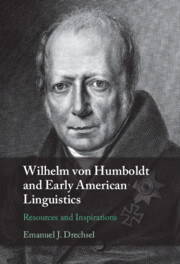Book contents
- Wilhelm von Humboldt and Early American Linguistics
- Wilhelm von Humboldt and Early American Linguistics
- Copyright page
- Dedication
- Contents
- Figures and Tables
- Maps
- Preface
- Acknowledgments
- Part I Wilhelm von Humboldt and the Americas
- Part II The Early Lives of Wilhelm and Alexander von Humboldt
- Part III Wilhelm von Humboldt’s Americanist Linguistics
- 6 First Exposure to American Languages at the Vatican Library in Rome and the Significance of Alexander’s American Resources (1803–1808)
- 7 Expansion and Intensification of Humboldtian Americanist Linguistics
- 8 Les langues du Nouveau Continent
- 9 From the Americas to the Pacific
- Part IV Wilhelm von Humboldt’s Impact on Americanist Linguistics and Anthropology
- Part V Wilhelm von Humboldt as an Americanist Linguist and Anthropologist
- Book part
- References
- Index
7 - Expansion and Intensification of Humboldtian Americanist Linguistics
Methodological and Theoretical Implications (1811–1819)
from Part III - Wilhelm von Humboldt’s Americanist Linguistics
Published online by Cambridge University Press: 11 January 2024
- Wilhelm von Humboldt and Early American Linguistics
- Wilhelm von Humboldt and Early American Linguistics
- Copyright page
- Dedication
- Contents
- Figures and Tables
- Maps
- Preface
- Acknowledgments
- Part I Wilhelm von Humboldt and the Americas
- Part II The Early Lives of Wilhelm and Alexander von Humboldt
- Part III Wilhelm von Humboldt’s Americanist Linguistics
- 6 First Exposure to American Languages at the Vatican Library in Rome and the Significance of Alexander’s American Resources (1803–1808)
- 7 Expansion and Intensification of Humboldtian Americanist Linguistics
- 8 Les langues du Nouveau Continent
- 9 From the Americas to the Pacific
- Part IV Wilhelm von Humboldt’s Impact on Americanist Linguistics and Anthropology
- Part V Wilhelm von Humboldt as an Americanist Linguist and Anthropologist
- Book part
- References
- Index
Summary
While engaged in helping rebuild a post-Napoleonic Prussia and Europe after his Roman years, Humboldt pursued several linguistic projects: a linguistic cartography of Europe applicable to other continents; initial analyses of Nahuatl; grammatical sketches of seven other Mexican languages; a programmatic comparative-contrastive statement of linguistics in “Essai sur les langues du nouveau Continent;” an in-depth analysis of Quechua of the Andes plus grammatical sketches for Araucano (Mapuche), Guaraní, and Muisca of South America; comparative studies of Aztecan, Mayan, or Tupian language families and linguistic areas; introduction to Massachusett, Mahican, and Onondaga grammars of eastern North America; noun incorporation versus polysynthesis; growing understanding of verbal morphology, including the zero morpheme; “inner forms” of American languages; attention to language contact and also to extralinguistic, sociocultural scenes and wider contexts as part of comprehensive descriptions and explanations of differences and changes in languages without literary traditions in substitution of historical records.
Keywords
- Type
- Chapter
- Information
- Wilhelm von Humboldt and Early American LinguisticsResources and Inspirations, pp. 117 - 143Publisher: Cambridge University PressPrint publication year: 2024



